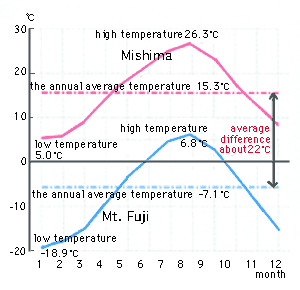Japan's climate changes between four seasons. As the season changes so does the air mass.
Air mass is an extensive volume of the atmosphere having essentially uniform temperature and humidity conditions. It originates where the atmosphere has a high pressure allowing the air to absorb the temperature and humidity characteristics of the surface.
 |
| Map of a low pressure air mass leading with a high pressure air mass following |
During spring, low pressure air masses from China enters Japan giving strong, warm winds in a low pressure zone from the Pacific Ocean. For summer, it is a rainy season. There is a mix of high pressure cold air and warm air. High pressure mass of cold air develops over the north of Japan and the warm air occurs over the pacific to create moist air creating a rainy season front. In early autumn, Japan is stuck by typhoons. Typhoons are the same as hurricanes. Typhoons are large masses of tropical low pressure air in the North Pacific. The formation of a typhoon has a strong Coriolis effect, high sea surface temperature, wind speed change, and low level water vapor. In winter, the winds pick up moisture and drop the moisture west of Japan to make rain and snow. Mount. Fuji's highest temperature does not exceed 15 degrees Celsius.
 |
| Monthly average temperature at Mt. Fuji |
Mt. Fuji has an orographic precipitation. Air is cooled as it is forced aloft in order to rise over a barrier such as Mt. Fuji. Most of the precipitation occurs on the windward side of the mountain with a dry region existing on the other side of the mountain called leeward. The air flows over the mountain, creating warm, dry downslope winds called Lee winds.
 |
| Air flow from high pressure to low pressure creates a topographic barrier. Air runs over Mt. Fuji then flows down to create updrafts, downdrafts, and rotors |
Clouds form when air and water meets the mountain. This makes air drift up the incline for vapor to be concentrated. Some clouds are a sign of weather change. A particular cloud called Lenticular is usually found above Mt. Fuji.
 |
| Summer clouds |
 |
| Winter clouds |
 |
| Air parcels must be at the lifting condensation level or dew point for clouds to form |
 |
Lenticular clouds over Mount. Fuji
|
References